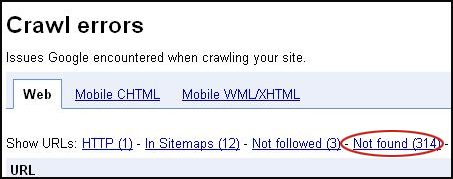Learn/Quick-SEO-Fixes-for-Internal-Links
Revision as of 00:03, 10 March 2011 by Aliza Earnshaw (talk | contribs)
By [[User:|]] on
Watch out - your link juice could be leaking. Links from authoritative sites that could [[Website-Visibility-Report|help your site rank higher in search results] may be going to obscure pages on your site, and languishing there. Links to pages with discontinued products, expired promotions or years-old press releases probably aren't doing your site as much good as you'd like.
Not sure what we mean by link juice? It's the value that a web page gets when other websites link to it. Search engines understand that when people take the trouble to link to a web page, that can indicate the page offers valuable information. That's why a web page that has inbound links from reputable websites can rank higher in search results.
Good inbound links to older, seldom-viewed pages on your site aren't doing you as much good as they could. Below you'll find seven ways to cork the leak by managing links between pages within your site - called internal links.
1. Newsletter Archives
- (Even if you don't have any, there's value for you at the end of this section.)
Check the incoming links to your old newsletters. (Don't know how to check links? Read Keep Track of Inbound Links.) If you've got good links to a newsletter that's out of date but still on your site, link from that newsletter to pages you really want people to see. To create these links, make sure you use anchor text that makes sense. The four readers that a 2004 newsletter attracts each year will not mind. Make sure you strip out any unneeded links that could distract from the ones that matter.
Oh you don’t have a newsletter archive? While it may take some time, why not see if there is some adspace available on old newsletters. I’m sure there’s plenty of companies out there that would gladly pimp out their old newsletters for a few extra bucks.
2. Webmaster Tools
Google Webmaster Tools is a great way to check incoming links to your site, and lots of other things, too. The Not Found section, pictured below, shows all of the pages that Google can no longer find. It also shows the number of links pointing to each page.
If the incoming links are still valuable, you could redirect one of the Not Found pages to a page on your site that you want people to find. You could also 301 redirect some of these pages to your site's home page.
3. Unused Web Pages or Sites
Perhaps you have old landing pages for contests or promotions, or you created some separate sites for one reason or another. All of these may have inbound links that aren't being used to their fullest potential.
For example, Starbucks has an old contest page with hundreds of inbound links - and they haven't done anything to reap the goodness of those links. While Starbucks probably need the links from this contest to rank well in search results, 99 percent of other companies do. So....
- Find any websites or web pages you no longer use that have inbound links.
- Use a 301 redirect to send people from these pages or sites to the pages on your site you want people to see.
You'll get the benefit of the inbound links, and direct people where you want them to go.
4. Old Press Releases
You may have a press release archive on your site that goes back years and years. You can make better use of any links to these releases by doing the following:
- Find releases that have inbound links and that are still cached relatively frequently.
- Just as you did with your old newsletters, find some anchor text you can use to link to the pages that matter to you now, and link to those pages.
- Strip out any old, unnecessary links.
- Reward yourself by reading other people's awkward office conversations.
5. Duplicate pages that split link juice
Here's another issue that can be addressed by digging into Webmaster Tools. Under Diagnostics, you'll find the HTML suggestions tab, where you'll see any duplicate title tags.
Two pages with the same or similar content could both have good inbound links. If so, you're taking the goodness of those links and splitting it, when it would be far better to get all the link juice going to one page.
If you really do have pages you've duplicated exactly - or nearly so - you'll want to keep the one that has inbound links and get rid of the other. If both have inbound links, redirect one to the other, using a permanent 301 redirect.
Sometimes pages are accidentally duplicated because of capitalization in the URL. For example, MySite.com/Bananarama and MySite.com/bananarama could be pages with different content or the same content. In either case, you'll need to decide whether to redirect one page to the other, move some content to a completely different page, or delete an unnecessary page.
To avoid splitting link juice, make sure your URL structure is consistent across your site.
Don't forget that the title tags themselves represent a great opportunity to get more people clicking on your pages in search results. Read Increase Site Traffic with Title Tags to learn how.


